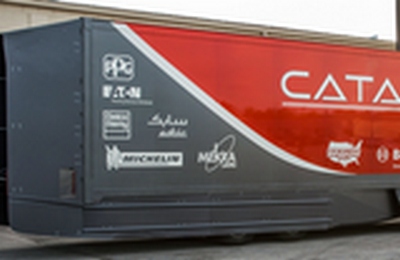SUPERTRUCKS GALORE
December 14, 2016 Vol. 13 No. 25
Navistar unveiled its Catalist SuperTruck on September 28, reporting a 104% improvement in freight efficiency compared to the U.S Department of Energy’s control vehicle, managing a commendable 13 mpg. The truck also demonstrated an impressive 50.5% brake thermal efficiency, and Navistar says it’s on the path towards 55% BTE.
Note that the DOE program’s goal is a 50% improvement in overall freight efficiency on a class 8 tractor-trailer as measured in ton-miles per gallon of diesel. Compared to a 2009 base model rig, that is. The Catalist exceeded that goal by a pretty big margin.
And now we know a little more about how it was achieved. Much of the improvement came from the slick Wabash trailer. The company says, of its numerous aerodynamic devices, three of them are based on the commercially available Ventix DRS skirt, AeroFin XL tail device, and nose fairing. They reduced the trailer’s drag coefficient by more than 30%, according to Navistar.
Each of the trailer components on the SuperTruck vehicle were designed as concepts of what the next generation of its aerodynamic devices will look like, the company says.
BEYOND THE AERODYNAMIC TRICKERY, Wabash also reduced the trailer’s weight by more than 2000 lb compared to its 2009-model dry van. All components used to reduce weight, like wide-base single tires and a variety of aluminum parts, are commercially available.
According to the DOE’s Office of Science, about 20% of the SuperTruck efficiency improvements come from advances in the truck’s engine, with further gains attributed to reduced rolling resistance with high-efficiency tires and idle limiters, as well as the aerodynamics and weight reduction.
 Some of the technology innovations developed through the program are already being implemented in production vehicles now, says Navistar.
Some of the technology innovations developed through the program are already being implemented in production vehicles now, says Navistar.
One of them was predictive cruise control, which looks ahead of the vehicle and recognizes terrain, continuously calculating the most efficient speed and gear for better fuel economy in real time.
THE TRACTOR’S AERODYNAMIC DRAG was much reduced through replacement of cab- and hood-mounted mirrors with a series of cameras and interior-mounted monitors, which also yield equal or better indirect vision for the driver. You’d see that solution everywhere already if the law didn’t demand outside mirrors.
There’s also a new LED headlamp system that reduces lamp size for a more aerodynamic shape and cuts electrical power requirements by more than 80%, while improving output and light color for improved night-time vision and reduced driver fatigue.